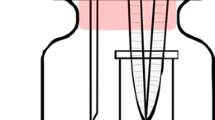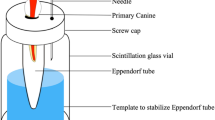Abstract
Objectives
The purpose of this study was to assess the amount of apically extruded debris during the preparation of oval canals with either a rotary file system supplemented by the XP-endo Finisher file or a full-sequence self-adjusting file (SAF) system.
Materials and methods
Sixty mandibular incisors were randomly assigned to two groups: group A: stage 1—glide path preparation with Pre-SAF instruments. Stage 2—cleaning and shaping with SAF. Group B: stage 1—glide path preparation with ProGlider file. Stage 2—cleaning and shaping with ProTaper Next system. Stage 3—Final cleaning with XP-endo Finisher file. The debris extruded during each of the stages was collected, and the debris weights were compared between the groups and between the stages within the groups using t tests with a significance level set at P < 0.05.
Results
The complete procedure for group B resulted in significantly more extruded debris compared to group A. There was no significant difference between the stages in group A, while there was a significant difference between stage 2 and stages 1 and 3 in group B, but no significant difference between stages 1 and 3.
Conclusions
Both instrumentation protocols resulted in extruded debris. Rotary file followed by XP-endo Finisher file extruded significantly more debris than a full-sequence SAF system. Each stage, in either procedure, had its own contribution to the extrusion of debris.
Clinical relevance
Final preparation with XP-endo Finisher file contributes to the total amount of extruded debris, but the clinical relevance of the relative difference in the amount of apically extruded debris remains unclear.

Similar content being viewed by others
References
Siqueira JF Jr, Rocas IN, Favieri A et al (2002) Incidence of postoperative pain after intracanal procedures based on an antimicrobial strategy. J Endod 28:457–460
Bürklein S, Benten S, Schäfer E (2014) Quantitative evaluation of apically extruded debris with different single-file systems: Reciproc, F360 and OneShape versus Mtwo. Int Endod J 47:405–409
Siqueira JF Jr (2003) Microbial causes of endodontic flare-ups. Int Endod J 36:453–463
al-Omari MA, Dummer PM (1995) Canal blockage and debris extrusion with eight preparation techniques. J Endod 21:154–158
Reddy SA, Hicks ML (1998) Apical extrusion of debris using two hand and two rotary instrumentation techniques. J Endod 24:180–183
Azar NG, Ebrahimi G (2005) Apically-extruded debris using the ProTaper system. Aust Endod J 31:21–22
Ferraz CC, Gomes NV, Gomes BP, Zaia AA, Teixeira FB, Souza-Filho FJ (2001) Apical extrusion of debris and irrigants using two hand and three engine-driven instrumentation techniques. Int Endod J 34:354–358
Tinaz AC, Alacam T, Uzun O, Maden M, Kayaoglu G (2005) The effect of disruption of apical constriction on periapical extrusion. J Endod J 31:533–536
Kuştarci A, Akpinar KE, Er K (2008) Apical extrusion of intracanal debris and irrigant following use of various instrumentation techniques. Oral Surg Oral Med Oral Pathol Oral Radiol Endod 105:257–262
Üstün Y, Çanakçi BC, Dinçer AN, Er O, Düzgün S (2015) Evaluation of apically extruded debris associated with several Ni-Ti systems. Int Endod J 48:701–704
de Melo Ribeiro MV, Silva-Sousa YT, Versiani MA et al (2013) Comparison of the cleaning efficacy of self-adjusting file and rotary systems in the apical third of oval-shaped canals. J Endod 39:398–401
Metzger Z (2014) The self-adjusting file (SAF) system: an evidence-based update. J Conserv Dent 17:401–419
Crozeta BM (2016) Micro-computed tomography study of filling material removal from oval-shaped canals by using rotary, reciprocating, and adaptive motion systems. J Endod 42:793–797
Kirchhoff AL, Fariniuk LF, Mello I (2015) Apical extrusion of debris in flat-oval root canals after using different instrumentation systems. J Endod 41:237–241
Farmakis ET, Sotiropoulos GG, Abràmovitz I, Solomonov M (2016) Apical debris extrusion associated with oval shaped canals: a comparative study of WaveOne vs self-adjusting file. Clin Oral Investig 20:2131–2138
Vyavahare NK, Raghavendra SS, Desai NN (2016) Comparative evaluation of apically extruded debris with V-Taper, ProTaper Next, and the Self-adjusting File systems. J Conserv Dent 19:235–238
Alves FR, Marceliano-Alves MF, Sousa JC, Silveira SB, Provenzano JC, Siqueira JF Jr (2016) Removal of root canal fillings in curved canals using either reciprocating single- or rotary multi-instrument systems and a supplementary step with the XP-Endo Finisher. J Endod 42:1114–1119
Leoni GB, Versiani MA, Silva-Sousa YT, Bruniera JF, Pécora JD, Sousa-Neto MD (2016) Ex vivo evaluation of four final irrigation protocols on the removal of hard-tissue debris from the mesial root canal system of mandibular first molars. Int Endod J doi. doi:10.1111/iej.12630 [Epub ahead of print]
Schneider SW (1971) A comparison of canal preparations in straight and curved root canals. Oral Surg Oral Med Oral Pathol 32:271–275
DeDeus G, Reis C, Beznos D, de Abranches AM, Coutinho-Filho T, Paciornik S (2008) Limited ability of three commonly used thermoplasticized gutta-percha techniques in filling oval-shaped canals. J Endod 34:140–145
Myers GL, Montgomery S (1991) A comparison of weights of debris extruded apically by conventional filing and Canal Master techniques. J Endod 17:275–279
Koçak S, Koçak MM, Sağlam BC, Türker SA, Sağsen B, Er Ö (2013) Apical extrusion of debris using self-adjusting file, reciprocating single-file, and 2 rotary instrumentation systems. J Endod 39:1278–1280
Topçuoğlu HS, Düzgün S, Akpek F, Topçuoğlu G, Aktı A (2016) Influence of a glide path on apical extrusion of debris during canal preparation using single-file systems in curved canals. Int Endod J 49:599–603
http://www.dentsply.com.au/secure/downloadfile.asp. Accessed 21 September 2016
http://www.fkg.ch/products/endodontics/final-preparation/xp-endo-finisher. Accessed 21 September 2016
Topçuoğlu HS, Zan R, Akpek F, Topçuoğlu G, Ulusan Ö, Aktı A, Düzgün S, Ağırnaslıgil M (2016) Apically extruded debris during root canal preparation using vortex blue, K3XF, ProTaper Next and Reciproc instruments. Int Endod J 49:1183–1187
Capar ID, Arslan H, Akcay M, Ertas H (2014) An in vitro comparison of apically extruded debris and instrumentation times with ProTaper universal, ProTaper Next, twisted file adaptive, and HyFlex instruments. J Endod 40:1638–1641
Koçak MM, Çiçek E, Koçak S, Sağlam BC, Yılmaz N (2015) Apical extrusion of debris using ProTaper universal and ProTaper Next rotary systems. Int Endod J 48:283–286
Kfir A, Goldberger T, Koren T, Pawar AM, Abramovitz I (2016) Can size 20, .04 taper rotary files reproducibly create a glide path for the self-adjusting file? An ex vivo study in MB canals of mandibular molars. Int Endod J 49:301–306
http://www.protapernext.com/system-solution.html. Accessed 15 September 2016
http://www.redentnova.com/what-is-saf/clinical-guidelines. Accessed 15 September 2016
http://www.dentsply.com.au/www/770/files/endoactivatordfu.pdf Accessed 8 April 2017
Bürklein S, Schäfer E (2012) Apically extruded debris with reciprocating single-file and full-sequence rotary instrumentation systems. J Endod 38:850–852
Paqué F, Balmer M, Attin T, Peters OA (2010) Preparation of oval-shaped root canals in mandibular molars using nickel-titanium rotary instruments: a micro-computed tomography study. J Endod 36:703–707
de Melo Ribeiro MV, Silva-Sousa YT, Versiani MA, Lamira A, Steier L, Pécora JD, de Sousa-Neto MD (2013) Comparison of the cleaning efficacy of self-adjusting file and rotary systems in the apical third of oval-shaped canals. J Endod 39:398–401
DeDeus G, Souza EM, Barino B, Maia J, Zamolyi RQ, Reis C, Kfir A (2011) The self-adjusting file optimizes debridement quality in oval-shaped root canals. J Endod 37:701–705
Rödig T, Hülsmann M, Mühge M, Schäfers F (2002) Quality of preparation of oval distal root canals in mandibular molars using nickel-titanium instruments. Int Endod J 35:919–928
Siqueira JF Jr, Alves FR, Almeida BM, de Oliveira JC, Rôças IN (2010) Ability of chemomechanical preparation with either rotary instruments or self-adjusting file to disinfect oval-shaped root canals. J Endod 36:1860–1865
Versiani MA, Pécora JD, de Sousa-Neto MD (2011) Flat-oval root canal preparation with self-adjusting file instrument: a micro-computed tomography study. J Endod 37:1002–1007
Peters OA, Peters CI (2001) Cleaning and shaping of the root canal system. In: Hargreaves M, Cohen S (eds) Path ways of the pulp, 10rd edn. Mosbey Elsevier, Missouri, pp 283–348
Author information
Authors and Affiliations
Corresponding author
Ethics declarations
Conflict of interest
The authors declare that they have no conflict of interest.
Funding
The work was supported by the Goldschleger School of Dental Medicine grants, Tel Aviv University, Tel Aviv, Israel.
Ethical approval
This article does not contain any studies with human participants or animals performed by any of the authors.
Informed consent
For this type of study, formal consent is not required.
Rights and permissions
About this article
Cite this article
Kfir, A., Moza-Levi, R., Herteanu, M. et al. Apical extrusion of debris during the preparation of oval root canals: a comparative study between a full-sequence SAF system and a rotary file system supplemented by XP-endo finisher file. Clin Oral Invest 22, 707–713 (2018). https://doi.org/10.1007/s00784-017-2144-9
Received:
Accepted:
Published:
Issue Date:
DOI: https://doi.org/10.1007/s00784-017-2144-9




